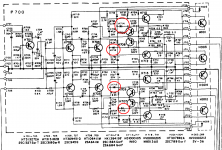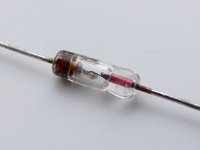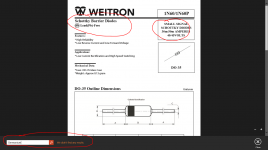Sorry for not being clear. I meant the transformer saturation part. I'm familiarized with rectification and smoothing phenomena.No problem ...
I tested the germanium diodes (1N60) from the power amp board. They have a voltage drop of about 0.38V - 0.4V and they all have a leakage current of about 3uA.
I have some BAT41 (0.38V - 0.39V drop), shall I replace them? I think they are for protection only.
I have some BAT41 (0.38V - 0.39V drop), shall I replace them? I think they are for protection only.
Attachments
Germanium do have high leakage and a low forward volt drop. That voltage sounds high for germanium tbh. Would have expected nearer 180 to 250 millivolt.
Germanium do have high leakage and a low forward volt drop. That voltage sounds high for germanium tbh. Would have expected nearer 180 to 250 millivolt.
http://phys.thu.edu.tw/~mengwen/exp-electronics/datasheet/1N60.pdf
Seems ok, typical is 0.32V.
I read that BAT41 is a good replacement for 1N60 but depends on application.
I guess here for protection would do, but I would like to be sure.
http://www.vishay.com/docs/85659/bat41.pdf datasheet for BAT41 diode
hfe variations will have a minimal effect at any part of the circuit. Your biggest problem is the other characteristics (not hfe) of the transistors in the power amp causing serious problems if you start swapping them for other modern types. You would need to rework and change some component values.
The preamp stages will work with pretty much anything.
There is no real reason to suspect the transistors will fail... as a general rule that doesn't happen. They should be as good as the day they were made.
I've had 2 amps (Sansui Eight / Au-777a), both 40 + years old, where the noise floor was drastically lowered by swapping out all the signal transistors in the pre-amp - It is my understanding that after 40 years they can break down ?
"It is my understanding that after 40 years they can break down ?"
That might be your understanding - but I am not aware of any evidence for it! More likely that very old (40+ .... how much +?) devices were inherently noisier than modern equivalents.
Unless over-stressed, semiconductors do not "wear out". Long term temperature cycling might eventually affect package seals and bonds, but that is a different story.
That might be your understanding - but I am not aware of any evidence for it! More likely that very old (40+ .... how much +?) devices were inherently noisier than modern equivalents.
Unless over-stressed, semiconductors do not "wear out". Long term temperature cycling might eventually affect package seals and bonds, but that is a different story.
I've got a 1970 build 1966 design dynakit ST120 amp with one original channel with BC108c input transistor , RCA 5 digit TO5 VAS and driver transistors on one channel. The other channel I repaired the damage with TO92 NTE249 transistor and drivers NTE49/50 from about 1990, also a RCA SK3441. Both sides use NTE60 output tranistors, probably white box equivalents of the MJ15003. The channels sound exactly the same, and both sides distort less and are quieter than my 1961 built dynakit ST70 tube amp with new power and rectifier tubes, film dielectric plate caps, and all resistors 100k and over changed to metal film. The driver board is original 7199 tubes."It is my understanding that after 40 years they can break down ?"
That might be your understanding - but I am not aware of any evidence for it! More likely that very old (40+ .... how much +?) devices were inherently noisier than modern equivalents.
Unless over-stressed, semiconductors do not "wear out". Long term temperature cycling might eventually affect package seals and bonds, but that is a different story.
I found the best improvement on the noise floor of the 1970 ST120 was to replace the tantalum input caps which produced popcorn noise, with 50 v 4.7 uf aerovox gold ceramic caps.
I wasn't impressed with the sound of Sansui receivers in 1973 when all the college dorm rooms were full of them with *****y bookshelf speakers. The college library had dynaco sca35 amps driving headphones, which I thought sounded very good, so I bought used examples of that. I'm an experienced musician
and had a good idea of what classical instruments (like piano) should sound like. The typical student owned receivers and bookshelf speakers didn't make the cut in 1970-73 IMHO.
BTW the germanium transistors I have had forward drops of about 0.3 v. I don't have any germanium diodes.
Last edited:
I also have a Sherwood S-5000 II that I still have to finish. Started the project few years ago but never quite managed to finish it. Still needs tubes and some k40y caps.
Yet, the Sherwood had also some carbon resistors that drifted. I only replaced a few there, they were heat stressed as I remember.
This Marantz also had a few that went over the tolerance. Yes, most were in spec and that could make you think they are all rock solid but some can go bad after 40 years in service.
Yet, the Sherwood had also some carbon resistors that drifted. I only replaced a few there, they were heat stressed as I remember.
This Marantz also had a few that went over the tolerance. Yes, most were in spec and that could make you think they are all rock solid but some can go bad after 40 years in service.
Seems ok, typical is 0.32V.
That is because its not a germanium device 🙂
Oh now I see 🙂 the pdf that I posted is not saying it's a germanium. I found the original datasheet:
http://pdf1.alldatasheet.com/datasheet-pdf/view/78466/ETC/1N60/+W747JUCRC/1JOY9+/datasheet.pdf
It is a germanium. And seems to have a larger V drop of 1V at 5mA
http://pdf1.alldatasheet.com/datasheet-pdf/view/78466/ETC/1N60/+W747JUCRC/1JOY9+/datasheet.pdf
It is a germanium. And seems to have a larger V drop of 1V at 5mA
Sorry I'm on my phone and the link must be bad:
http://www.alldatasheet.com/datasheet-pdf/pdf/78466/ETC/1N60.html
http://www.alldatasheet.com/datasheet-pdf/pdf/78466/ETC/1N60.html
Link doesn't work for me.
Your picture looks like a point contact germanium such as an OA47 type of device.
Your picture looks like a point contact germanium such as an OA47 type of device.
Yes I posted a link that is for mobile use. But I posted the good one. They must have kept the name for new production Shottky to suggest it is a direct replacement.
They look like germanium. Try connecting a 10k series resistor to one and put it across a 9 volt battery. Then measure the volt drop across the diode.
- Status
- Not open for further replies.
- Home
- Amplifiers
- Solid State
- to92 transistor replacement



